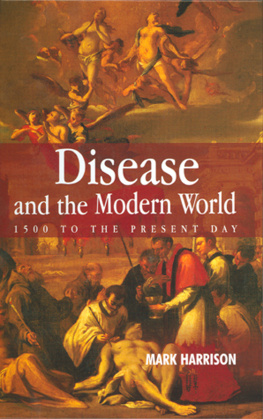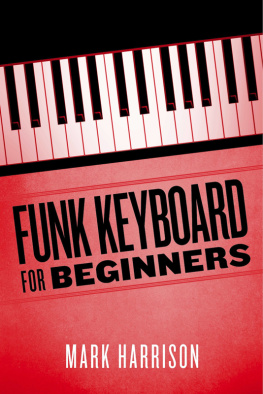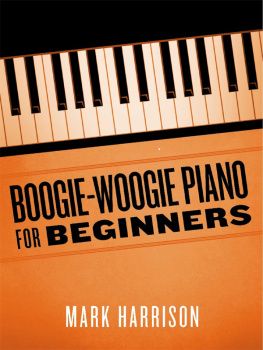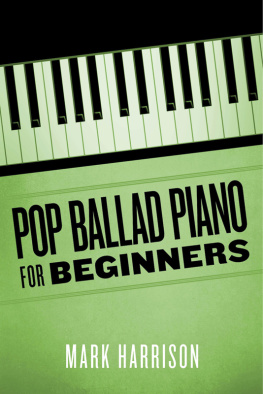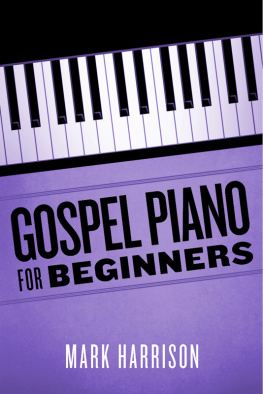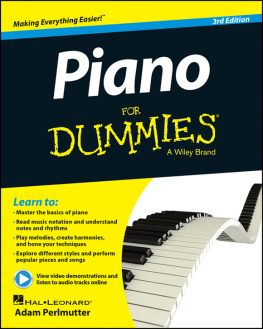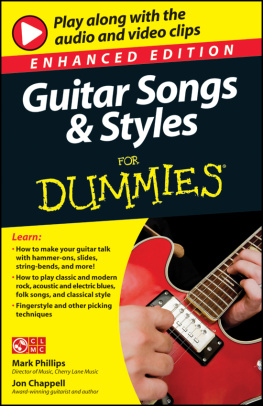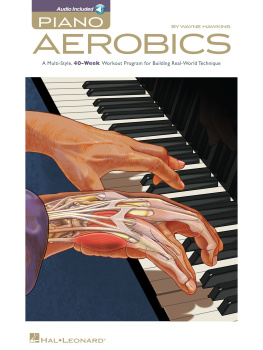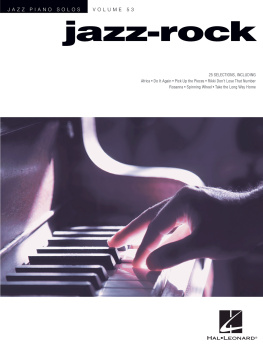Welcome to Rock Piano Chops . If you really want to jump-start your rock piano technique so you can play convincingly in modern and classic rock styles, then youve come to the right place! This book gives the beginning-to-intermediate player a complete rock piano workout: youll develop your rhythmic feel, dexterity, hand coordination, and voicing skills as you work through the fun and authentic exercises. Each example is recorded at several tempos, so you can choose the one thats right for you as you play along with the rock rhythm section on the audio.
First youll get started with the Chops-Building Exercises , which will fire up your technique and voicing chops as you comp (accompany) on some classic changes. Then your workout will really get into high gear in our Groove Lab , where youll work with straight and swing rhythmic subdivisions while learning four different ways (from simple to more complex) to play over each of the chord progression examples.
Then in Phrases and Licks Used by the Pros , well check out some key phrases and techniques used by top rock piano players, so that you can incorporate these ideas into your own music. Finally, in the Etudes section, we have longer pieces in the style of legendary rock pianists such as Bruce Hornsby, Chuck Leavell (Rolling Stones), and Billy Joel. These pieces will help you use your rock piano technique in a musically and stylistically effective way.
bout the audio
On the accompanying audio, youll find play-along tracks for almost all of the examples in the book, recorded at several tempos. For each track, the rhythm section is on the left channel and the piano is on the right channel. When you want to play along with the band, turn down the right channel to eliminate the recorded piano. When you want to hear the piano part for reference, turn down the left channel to eliminate the rhythm section. This is designed to give you maximum flexibility when practicing. The rhythm section tracks contain bass and drums, plus a selection of other instruments (guitar, synth, organ, and clavinet).
Chapter 1
Rock Piano Chops-Building Exercises
The Straight-eighths Rhythmic Feel
Most rock styles are written in 4/4 time and use patterns based around eighth or 16th notes. Each of these subdivisions can be played straight or swing , essentially resulting in four main rhythmic feels:
- Straight eighths
- Swing eighths
- Straight 16ths
- Swing 16ths
In this chapter, we will work on chops-building exercises using straight-eighths and straight-16ths feels. Then, in Chapter 2 (Groove Lab), we will incorporate the swing-eighths and swing-16ths feels.
In a straight-eighths feel, each eighth note is of equal length and divides the beat exactly in half, as follows:
There is audio content at this location that is not currently supported for your device. The caption for this content is displayed below.
Note the rhythmic counting below the notes. This is how eighth note rhythms are normally counted, with the 1, 2, 3, and 4 falling on the downbeats , and the &s falling halfway in between, on the upbeats . Check out Track 1 on the audio to get comfortable with this rhythm and counting concept. This is our first and most important rock rhythmic subdivision or feel, used by the majority of rock songs from the 1960s until the present day.
Straight-eighths Chops-Building Exercises
Now well get to the first set of chops-building exercises, using the straight-eighths rhythmic feel above. The goal of these exercises is to develop technical dexterity and hand coordination, while also learning chord voicings and rhythm patterns that are appropriate and stylistic for todays rock music.
The audio tracks for the exercises in this section are recorded at three different tempos: 65, 95, and 125 beats per minute (bpm). The exercises are repeated twice at each tempo on the audio tracks.
Depending on your playing level, you can start at the slowest audio tempo as needed, before moving on to the faster tempos. Make sure you are comfortable with the voicings and the rhythms shown, when playing at each tempo. You can check against the piano part on the right channel of the audio. You can also practice hands separately as needed, before combining the hands together on each exercise.
On to our first straight-eighths chops-building exercise.
Straight-eighths Exercise #1
There is audio content at this location that is not currently supported for your device. The caption for this content is displayed below.65 bpm
There is audio content at this location that is not currently supported for your device. The caption for this content is displayed below.95 bpm
There is audio content at this location that is not currently supported for your device. The caption for this content is displayed below.125 bpm
Here, the right hand is repeating the note D in octaves, over the different chords. (Repeating the same note over different changes is called a pedal point.) Within the right-hand octaves, the notes A and G create internal fourth and fifth intervals, with a hollow and transparent sound suited to modern rock styles. The right-hand voicings use mostly roots, fifths, and ninths on these chords, which also creates a modern sound. The left hand is playing the root of each chord in octaves, again typical for the style.
This groove has an interesting rhythmic alternation between the left- and right-hand parts. In each measure, the right-hand voicing lands on beat 2, which is a downbeat , and on the & of 3 and & of 4, which are upbeats . (See rhythmic counting and text for Track 1.) Meanwhile, the left hand is landing on the remaining downbeats (1, 3, and 4) in between the right-hand voicings, giving the pattern a solid foundation.
Beats 2 and 4 are also referred to as backbeats in rock styles, as these are normally where the drummer hits the snare drum. (Check the rhythm track on the left channel as needed.) In rock piano styles, the right hand will often reinforce one or both of these backbeats.
Straight-eighths Exercise #2
There is audio content at this location that is not currently supported for your device. The caption for this content is displayed below.65 bpm
There is audio content at this location that is not currently supported for your device. The caption for this content is displayed below.95 bpm
There is audio content at this location that is not currently supported for your device. The caption for this content is displayed below.125 bpm


